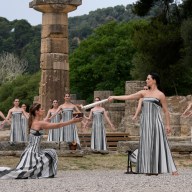 Takashi Matsuba tattoos a client using tebori at his studio in Brooklyn. Credit: Aymann Ismail, ANIMAL New York
Takashi Matsuba tattoos a client using tebori at his studio in Brooklyn. Credit: Aymann Ismail, ANIMAL New York
Tebori is Japanese for “hand-carved,” referring to the indigenous method of tattooing by hand using a sharpened bamboo stick called a nomi. Holding the nomi like a pool cue, artists insert the ink with a repeated stabbing motion.
Due to associations with the Japanese mafia, many tebori artists remain underground. Only a handful still live in Japan and, according to Takashi Matsuba, there’s only two practicing the art form in New York. He’s one of them.
Matsuba’s Brooklyn studio doesn’t have a sign. The tattoo artist isn’t particularly furtive; he’s eager to talk about his craft. He doesn’t announce himself because he isn’t interested in tattooing just anyone.
“Usually, people email me first,” he says. “Then I choose a customer.”
Matsuba began his career as an apprentice. A Japanese apprentice is more like a servant than a student. “You clean up. You cook food. They don’t teach you,” he explains.
Apprentices learn by watching their masters work. They practice on their own time. Matsuba practiced on his own skin. “When you are young, you don’t care. I was tattooing [myself] once every two days,” he says.
Before his client arrives, he mixes his inks. The inks are one of the ways he can distinguish a hand-poked tattoo from one made by machine. Most tattoo shops are limited to what’s commercially available. “We make our ink ourselves,” Matsuba says. “I can see if that’s my own ink, or bought ink.”
He also makes his own nomi. He used to use a simple piece of sharpened bamboo, which is more traditional, until he was forced to switch. “In the United States, you can’t use it because of the health department. They have a law. You have to use something sterilizable. I was using something like this at a convention and the health department stopped me,” says Matsuba.
His client today has requested a tattoo of a chrysanthemum. That’s all the input the client of a horishi — Japanese for “trained artist” — will typically be allowed to give. Matsuba has created an outline and picked out the colors.
He outlines the tattoo with a tattoo machine. Matsuba thinks tebori’s chief strengths lie in shading and gradation. For the black outline, the machine works just as well.
The rest he pokes by hand. He dips the tip of the nomi in the colored ink, poking the skin with a quick rhythm. A tattoo machine’s electric hum masks the sound of needle piercing flesh, but the sound of needles is plainly audible. It sounds like someone repeatedly pressing their lips together very lightly. Matsuba says he finds the sound soothing.
Tebori is often thought to be more time-consuming and painful than machine tattooing, but he disagrees. A skilled tebori artist can work just as fast as a machine, and the amount of pain comes down to the artist, not the method. “If you’re trying to get a whole back piece, yes, it’s painful,” he admits. “But the machine is the same. I think the machine is more painful.”












